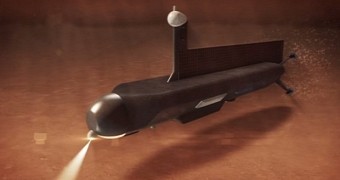By the looks of it, NASA has grown a tad sick and tired of sending rovers and orbiters to planets and other celestial bodies in our Solar System or well beyond it. Hence the fact that it is now thinking about making the switch to launching submarines into space.
That's right, guys and gals working with this space agency are actually considering sending submarines to explore neighboring worlds. Specifically, they want to launch such a robotic submersible vehicle to Saturn's moon Titan and have it explore its lakes and seas.
Why send a submarine to Titan of all moons and planets?
Not to play Captain Obvious or anything of the sorts, but it goes without saying that, if you're going to launch a submarine into space, you'd better make sure that, once it's done traveling through the cosmos and reaches its target, is has some liquid environment to take a dip in.
This is precisely what makes Saturn's moon Titan the perfect target for such a mission. As explained by astronomers, data obtained with the help of telescopes indicates that this celestial body hosts a whole lot of lakes and even seas on its surface.
True, these seas and lakes on Titan are not composed of water, but of liquid hydrocarbons. Still, NASA scientists don't expect that this will in any way interfere with their submarine's exploration agenda. On the contrary, it will make the mission all the more exciting.
The astronomers who came up with the idea to send a submarine to Titan hope to deploy the robotic submersible vehicle in a polar sea dubbed Kraken Mare. This body of liquid hydrocarbons is about the size of the Great Lakes and has an average depth of 300 meters (nearly 1,000 feet).
Seeing how temperatures on this moon of Saturn are well below zero and very little is known about the currents agitating the hydrocarbon lakes and seas, there is little doubt that the mission will prove a tricky one. Then again, chances are that it will all be worth the trouble in the end.
OK, so what would this submarine look like?
For the time being, the submarine that NASA scientists hope will soon swim around Titan's seas and lakes is but a concept. Simply put, NASA does not yet have a detailed design of this planned robotic submersible vehicle to show us.
Still, engineers with the space agency expect that, if built, the submarine would tip the scale at about a ton and move around with the help of turbines. In turn, these turbines would be kept up and running by a radiothermal generator designed to produce about 1kW of power.
The submersible vehicle would move at a speed of about 1 meter per second (approximately 3 feet per second) and would surface once every 16 hours to beam whatever data it managed to collect while submerged back to Earth, NASA scientists explain.
Should things go as planned, this high-tech submarine could be completed and launched sometime around the year 2040. Meanwhile, the space explorers behind this project have a whole lot of details to sort out and plenty of puzzles about how the vehicle would actually work to solve.

 14 DAY TRIAL //
14 DAY TRIAL // 